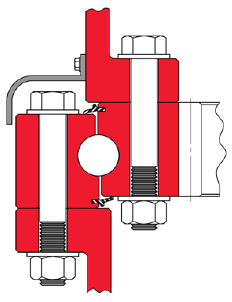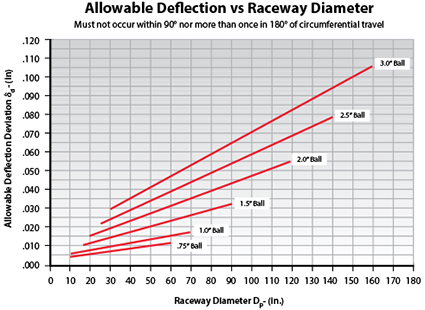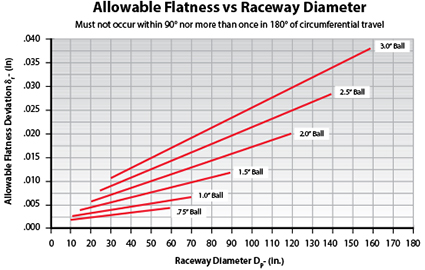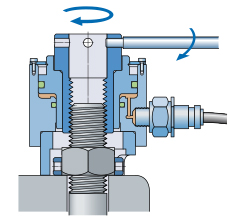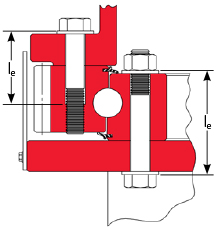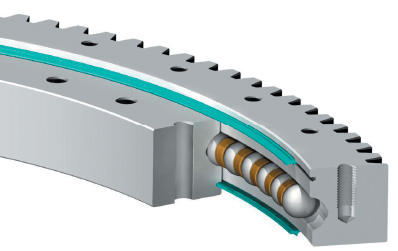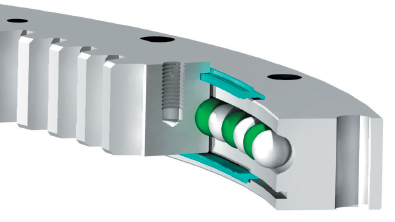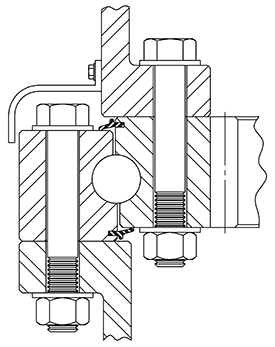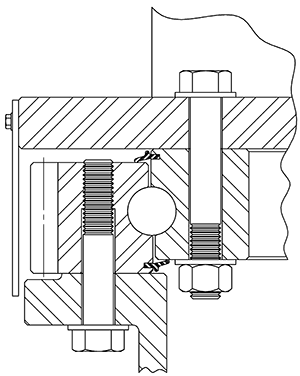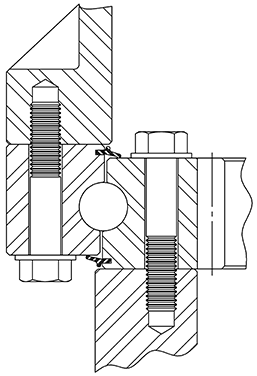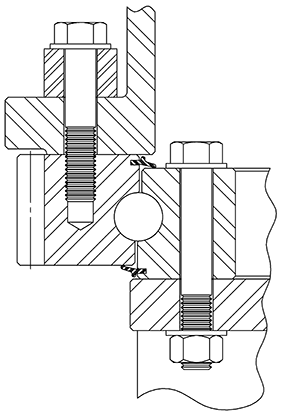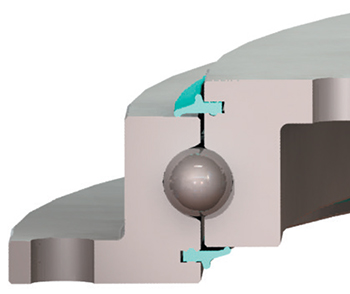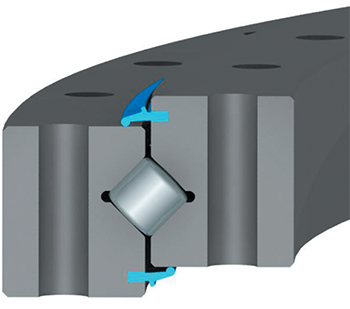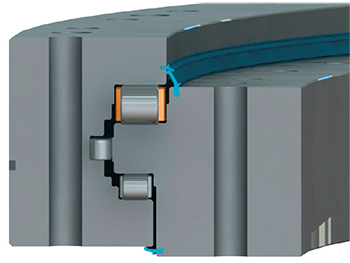Crossed Roller Bearings
Crossed Roller Bearings
Crossed-roller bearings are bearings for high-precision applications whose dimensions conform to ISO dimension series 18 as per DIN 616. They comprise outer rings, inner rings, rolling elements and plastic spacers. The outer ring is split and is held together by three retaining rings.
Due to the X arrangement of the cylindrical rollers, these bearings can support axial forces from both directions as well as radial forces, tilting moment loads and any combination of loads by means of a single bearing position. As a result, designs involving two bearing positions can be reduced to a single bearing position.
Crossed roller bearings are very rigid, have high running accuracy and are supplied with normal clearance, low clearance or preload. The bearing outer rings are easily fixed to the adjacent construction using clamping rings.

The Basis of crossed roller bearings
Crossed roller bearings provide more accuracy, rigidity, and weight-bearing capacity for linear motion than other commonly used friction-reducing devices such as ball bearings. And unlike ball bearings, they can support moment loads, radial forces or tilting loads. This lets one crossed roller bearing replace more than one ball bearing, thus saving the space required by ball bearings, lowering the associated material costs.
Crossed roller bearings are preferred for high-precision linear-motion applications with relatively short linear movements that require smooth motion. They are also durable, lasting 150 million cycles, even for linear-motion applications with high levels of acceleration and deceleration when using 2 to 12-mm rollers and 30 to 600-mm lengths.
They can be found in medical and lab equipment, machine tools, semiconductor processing, clean rooms, vacuum environments, material handling, and automation machinery. And as technology becomes more demanding, requiring greater and greater precision, crossed roller bearings will also become more common.
Crossed Roller Bearing Basics
A crossed roller bearing, also called a crossed roller slideway, is effectively two sets of
bearings and races combined at right angles to each other. Cylindrical bearings or rollers mount along the length of a rail in a carriage. The rollers are held in place with a cage, preventing roller-to-roller contact, which increases friction and wear. Keeping rollers separated also eliminates any risk of them jamming.
If you were to number the cylindrical rollers along the rail, the even ones would be mounted at 90° to the odd ones. In other words, the rollers alternate orientation. This lets the line of alternating rollers support loads from all directions, including high overturning moments, and because they do not recirculate like some ball bearings that line linear rails, all the rollers are constantly carrying the load except for pure radial loads, where, due to the criss-cross arrangement, only half of the rollers take loads at any one time.
The cylindrical rollers are mounted such that they create a protruding V-shape on the sliding rail. It fits into a corresponding V notch in the other rail that is likely carrying
the load.

Rollers provide a full line of contact rather than just the point of contact a ball bearing provides. This gives crossed roller bearing a broader contact surface and the ability to carry heavier loads. It also increases the bearing’s rigidity so it deforms less and is thus more accurate. Plus, erosion is slower due to the crossed rollers’ consistency of contact between the carriage and the base.
There is a direct correlation between the combined contact area of all the rollers and load capacity: the greater the area, the higher the capacity. This lets bearing designers adjust load capacity by up to 250% by mounting rollers closer together. This permits more rollers to fit in the same space and increases the amount of weight per inch the bearing can carry.
Cross roller bearing do not use seals due to their construction, high precision, and low friction. Still, it is important to keep contaminants away from the rollers to prevent damage and wear. One way this is done, especially in IC manufacturing and lab equipment, is to install the machines using crossed roller bearings in clean, contamination-free environments.
It is also important to lubricate crossed roller bearings to get the most operational life out of them. A standard lubricant for them is lithium-soap-based #00 grease.
The configuration of crossed roller bearings gives designers all the benefits of a two-row bearing, including stability, in a single-row space.
Accuracy and Rails
Because of crossed rollers large contact area, they deform less than recirculating ball bearings and are stiffer, creating more precise and consistent motion. Because of this greater stiffness, crossed rollers provide consistently precise movement.
Crossed rollers are less forgiving of mounting surface inaccuracies than recirculating ball bearings due to their rigidity and the way they are designed. Ball bearings can handle imperfections on the order of five to ten 10 microns while crossed roller bearings need imperfections smaller than two microns for ultra precision.
Metal and Plastic Cages
One factor that determines how close rollers can be to each other is the cage (or retainer) holding them all in place, so its design is critical. An important factor in the design of the cage is whether it is made of metal or plastic.
Traditional metal cages use tabs on the carriage that fit into notches on the top and bottom of the rollers to keep them in place. This limits how closely a roller can be positioned between neighboring rollers, which then limits the crossed roller bearing’s load-carrying capacity.
But metal cages are less expensive and can be plain or stainless steel. Metal is more compatible with working in vacuums, including outer space, because plastic can out-gas and cause problems with electronics and optics. Stainless steel can also be beneficial in high-temperate applications and those requiring washdowns and where rust is unacceptable.
Plastic cages fit smoothly around each roller, exposing more of it to the load than a metal cage can. Plastic cages also pack rollers closer together so more rollers can be housed in the same rail. These two features mean the cage and rollers can be shorter while maintaining the same load capacity or the number of rollers can be increased within the same cage (compared to a metal version) and thus increase the load capacity. In fact, a plastic cage can yield a 30% to 58% increase in contact area compared to a metal cage. This increase translates to a 250% increase in load capacity.
Recent development in plastic cages has increased the number of design options available to engineers. They can now be shaped so that there’s even a larger contact area with less space between rollers. Plastic cages can also be thinner in critical areas.
Preventing Cage Creep
Metal and plastic cages both effectively float between the bearing’s rails and they both tend to drift away from the bearing’s longitudinal center over time, a phenomenon called cage creep. It happens when the linear bearing only makes partial strokes, especially when mounted vertically. The cage can restrict slide travel because once the cage has moved and the bearing makes its next full stroke, the off-center cage hits a rail endstop and is forced to center itself by skidding.
Hitting the endstop and skidding can damage the retainer, rollers, and slideway. And it could require a more powerful and expensive motor to offset the effects of creep. Cage creep also means the rollers are not rolling but slipping and causing metal-to-metal rubbing, which leads to wear.
If a crossed roller bearing has no defense against creep, technicians will often have to regularly readjust the linearmotion equipment and replace worn components. Creep
is particularly bad when applications require high levels of acceleration and deceleration, uneven preloading or load distribution, or vertical or inclined strokes.
Fortunately, there are anti-creep mechanisms that stop retainers from slipping by holding the rollers between the two V-grooved slideway rails. As a result, the rails can be used in any mounting orientation, and lower-momentum motors such as linear motors can be used to move the loads. Anti-creep devices also reduce downtime and the cost of maintenance.
One anti-creep device, a rack-and-pinion mechanism, consists of external plastic gears and a metal gear inside the rail. Though effective, this approach is costly and makes it impossible to change out failed or worn bearing components.
Another approach to preventing creep uses rollers with spherical studs circling the middle of the roller’s round surface. As the rollers turn in the rail, they mesh with a row of holes or dimples machined down the exact center of the raceway tracks. This design, called Studroller at NB, prevents slipping regardless of the rail’s orientation or position. It creates smoother tracking motion than gear-based anti-creep mechanisms, so it is quieter and more accurate. Keeping the rollers aligned along the center of the rail also keeps all components aligned.
With the Studroller approach, the number of effective rollers increases by 20% to 55%. Contact area between rollers and the raceway surface jumps by 42% to 58%, which lets the load rating increase by 140% to 230%. This should lead to savings in cost and space required to mount the linear bearing.
Costs vary for crossed roller bearings with anti-creep devices depending on the complexity of the device whether the application must be custom designed and manufactured to accommodate them. The Studroller approach, being the simplest non-slip design, is priced the same as a standard crossed roller slideway, which is roughly half the cost of other anti-creep devices. And there are no redesign costs to replace a standard slideway.
Travel Lengths
For crossed roller bearings on linear sliderails, the rails’ lengths determine the length of the stroke or travel. The entire rail assembly must be twice as long as the stroke. That’s because both rails containing crossed roller bearings move in opposite directions. That means the whole assembly has to have room to move inside a space twice as long as the travel length. (Recirculating-ball bushings used for linear motion need shafts only as long as the required travel because the only moving component is the bushing.)
When the bearing uses plastic cages, stroke length can be longer on a given length of rail because the cage can be shorter for a given load.
So one limit on a crossed roller bearing’s travel is the space available in the application. As mentioned, with the rails moving in opposition to each other, the overall space required is twice the distance the load will travel. Endstops are components mounted on linear rails that physically limit travel length, stopping the rails from going farther.
Ratings and Life
The dynamic load ratings of crossed rolling bearings are based on the industry standard of 50 km of travel. In effect, it means that when you purchase several crossed bearings, 90% of them will last at least 50 km under normal operating conditions at its rated load. Using bearings with load ratings higher than an application requires usually lets the bearing last longer or withstand more demanding conditions.
It’s also important to select bearings with a margin of extra load capacity if accuracy is paramount. That’s because rollers and rails can deform when nearing their load limits, which can change the accuracy, sometimes permanently.








